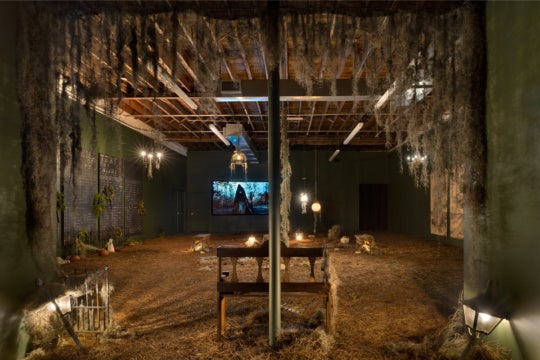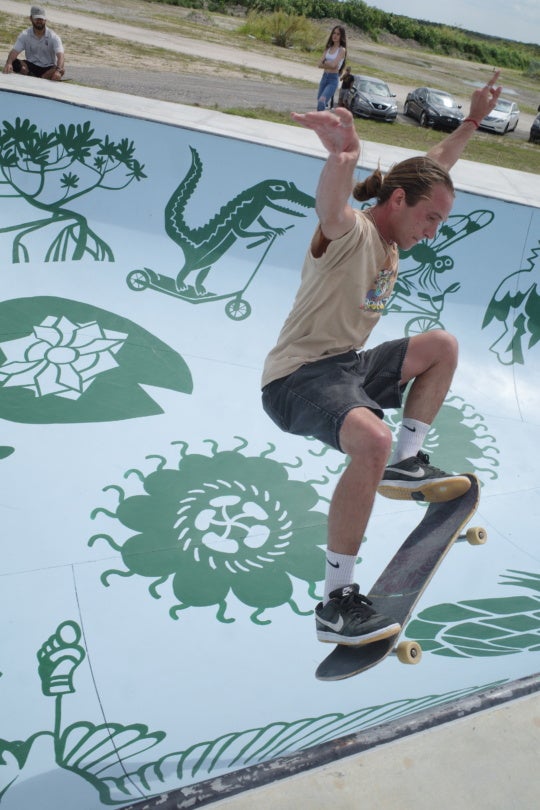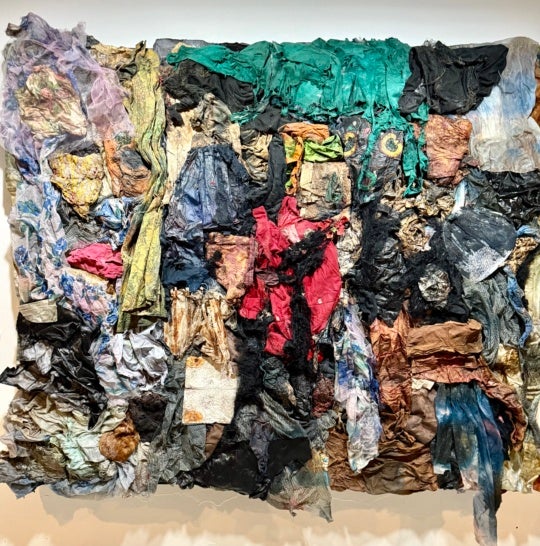Andy Cherewick is a prolific artist who has lived and worked in Athens, GA for almost two decades. He is a painter’s painter who is diligent in his studio, and consequently a great role model. Cherewick is intelligent, well-read, and a true conversationalist. I recently had the pleasure to talk with him in his studio, where we touched on the realities and challenges of working in the studio, discipline, fear, inspiration, and the process of decision making.
Rusty Wallace: Could you talk about your average workday?
Andy Cherewick: Oh that’s pretty straightforward. Anywhere between 7 and 5. Not anywhere, almost exactly 7 to 5. Up until this year, I never even had weekends, but I really wanted to make sure I keep my girlfriend. So now I have weekends! She has a straightforward Monday-Friday job; so I observe weekends and make it happen.
For me, when I do stop for shows or travel, and a break goes longer than two weeks, it’s actually really hard to get back in. So just out of fear and avoidance of pain and misery, it’s easier to just work everyday because of deterioration of mechanics of a picture. Like if you get away from it, all of sudden, what do I do with this? I don’t even see it. Me and Jeffrey [Whittle] used to talk about it all the time. Specifically, I’m very jealous of writers because that pattern of working, to me, seems way more humane. That’s what I want to do, that’s my ideal rhythm. The one I have for painting is kind of imposed of me, not the other way around. In order to stay on the horse, I have to do it. I’d rather not.
RW: That’s the reality of discipline. Discipline isn’t fun, but it’s necessary.
AC: I’m glad it’s not the other way. I would much rather not have those feelings of anxiety. And when you work everyday, there’s not any question about that behavior— you’re in the mess, you’re in the thick of it. And you’re just working on five different levels of problem solving. Climbing back on the greased pig, once you’re thrown off, is really anxiety inducing to try and figure out how to re-manage.
RW: You maintain that dialogue and that immersion, and things just kind of form.
AC: Yeah, and if you’re just huffing the fumes all the time, then there’s really no concern about on or off. And that was always a big deal when I was younger. When things start to lose the plot, I could use that for long periods of time. The work becomes not just impotent…
RW: Scattered?
AC: Yea, and nothing. And no work. Whereas here, I can feel the slack in the line every day. If it goes bad, I know exactly which way it went bad and exactly how. Which is probably an over-elaborate way of having a control problem—making sure you have absolute control.
RW: I think there’s something to the necessity of tension in any kind of creative pursuit. And a lot of my fellow artist friends say the same thing. Balancing their creative work with their life…all those facets of the day to day experience. When they feel that that tension is lessening, it’s a scary thing because that is connected to urgency. It’s connected to your motivation, your daily motivation.
AC: And your work could go scarecrow at that point.
RW: One day you walk in your studio, and you’re like “what am I doing?”
AC: And once again the spirits left. And I don’t really believe in the idea of the muses or the spirits, but it’s useful language for very palpable experience. Whether you call it tension or angles of deflection. I can’t imagine it ever becoming more complicated than that.
RW: The reality is you have to get accustomed to the fear of going into the unknown. You go into the unknown on purpose. If you’re sincere about wanting to do something vital and meaningful, you have to take that step. Fear is always going to be there.
AC: And the key that is so important is that it’s yours, not the world’s. Everything you see in art magazines as artists that are addressing art world fears are boring. They’re absolutely pathetic. It’s bad.
RW: Incestuous.
AC: Every single person that’s ever played with stuff knows the difference like night and day when they’re afraid. And not afraid of failure, just afraid. And to put it poorly, I think that’s the moral component in art making. That level. And people that don’t have that are making decorations.
RW: Superficial.
AC: When you get to a place where you’re presenting your work and you’re looking at the work individually, are these guys doing something together? Are there little things going on inside them? What’s their relationship? Do they have enough to survive on their own when they get split up, sent to different places? Can each one transmit the story of whatever it is you’re telling in some way, shape, or form? Are you making sure each one of your works is doing that? For me, that’s the hardest thing to see and control and understand. And that is what is happening to your work versus what is happening in the world with your work.
More times than not, when I have a good day it’s because I did something really good for my work. And I think this is going to be great to put into the world, and the next day I realize “oh no, that was for me.” That’s not good enough for a piece, but it was good that I did it. That was a very short term good. And that’s my biggest allergy, fear, concern. When I see the work doing good and I start to realize that it’s doing good for me in a very vain way of showing me that I’ve learned something new. It’s good to do that, but I’ve got to be better to see the difference between that versus “this is actually going to be good to go out in the world and compete with things they should be able to compete with.”
RW: When you stop and try to think about it objectively, it doesn’t make any sense.
AC: And more times than not, it will slow down the work. It’s happened to me. You can fall into that. I am definitely a big fan of overthinking things, and it kills work. So I have developed really strict rules and guidelines to not fall into that trap.
RW: If you want to call that pragmatism, you can put that against its obvious counterpart—beauty. Beauty, when you stop and think about it, doesn’t make any sense. But that’s what’s amazing about it. In the same way, then art is amazing in any form: music, theatre, visual. We all have situations where we can get stuck. And I think that’s the great thing about art; it helps us go into new places, go into the unknown. But also to think about and to reimagine.
AC: What’s interesting to me is there’s seems to be a real dangerous difference between what this stuff is for us as ‘makers of stuff’ versus what this ‘stuff’ is for people that don’t make this stuff. And that’s a weird thing that I think I am hesitant to even think about too much. Simply because I’m in such a jam job in working all the time anyway, that I don’t want to take on that line of thinking right now.
RW: It really has nothing to do with artist involvement anyway.
AC: But it does inform me, or at least throws up some cautionary signs that almost help me in another way of what I am recording or taking note of. If there is a strange resource pattern, is there something that I am doing to help shift that in a better or worse way? Or is that something for the generals to worry about and I’m just a foot soldier?
RW: Going back to mentioning the muse…I don’t particularly subscribe to that, or at least the modern day use of that word. But I do find the original, older idea interesting, which wasn’t so much the feminine helper or deliverer of inspiration. It was more a kind of acknowledging that there are ideas in circulation and those ideas can’t do it own their own.
AC: Ideas coming through is more on the logos side. There’s like five or six holy demarcated different groups of aesthetics in Japanese thinking—I remember this from years ago. My favorite is yūgen, and that is the idea of things coming in and out of our world, or our immediate feeling. So it’s like this palpable human feeling that all humans share. But I love that one group of people put a name on it. Every culture has their own little thing, everybody has it. The idea of the muse is just another facet of the state of being conscious and what that means. With my daily work routine, I always feel that is the best way to beat the old idea of the muse. If you show up all the time, where is the muse going to hide? Whereas if you try to play this game with them, you will lose. You will always lose.
RW: You can’t wait for inspiration.
AC: And to me, inspiration is just another name for the slack in the rope that you weren’t working. So I am not inspired, I work ten hours a day. How can I have time to be inspired? Except I mean that in the most beautiful way, that time couldn’t be richer. But there’s no inspiration, it’s just going to work. I figured that out really quickly because all my friends were musicians. And they were all doing that feast and famine thing of working three months at a time, getting a chunk of change, and then recording for three weeks. And I couldn’t handle watching them do it. That seems like misery. The small, relatively regular way makes more sense to me.
RW: An obvious question for someone who sees your work, how do you feel about painting? Because the paintings are very “painterly.” Process of the making, constructing your images is very evident in your work. Do you think about that in terms of formal painting ideas?
AC: No. If anything, it’s kind of embarrassing to me that the thickness of them is just a problem I’ve always had. And it’s just because 85% of my marks are wasted, and ruined, and bad.
RW: It’s going into the unknown and finding the images—
AC: I am such a bad decision maker that one of my ways to compensate it is that I just paint all the time. That way the ratio just stays. But it’s true, I can just get lost so easily about a piece. So I will endlessly change parts of it over and over over and again. And end up right where I started. I no longer beat myself up about that, but the texture of the work is completely based on how much painting is going on. My dream painting? Super thin. Thin as the canvas. I looked at it; I did it, one take. That has never happened. I think I came really close maybe four or five years ago. Something happened, and I almost, almost finished something like that. I’m not even really sure I see what it is. When I look at my paintings, and what I identify them about me is maybe just the way the structure of the painting where paint is applied is handled so coarsely that the level of drawing and color choices. I consider to be this total husband and wife team—drawing is the husband, and color is the wife. They are married in a sense. And there’s this wonderful bridging and mutual rising.
I think one thing I’m most concerned about in the coming six months is for the work to expand a little bit. The goal is to finish a painting inside a month. The way my methods have sort of grown has been terrible. And I’m completely against all of it. I work on several things at once, and it takes several months. So I won’t finish a painting for four or five months, and then I finish eight. For whatever reason, I hate it. It drives me nuts. I want to sit down, spend two weeks, and boom, that’s a painting.
RW: It’s interesting you talk about your painting process and also reference your ideal process being more akin to a writer’s. In your eyes, you see this as “I’m just making mistakes. It’s just this big mess.” But as a viewer I wonder, “How could these not be this way?”
AC: And it gets into this nasty, murky water essentially that you’re never going to be enjoying the sound of your own voice.
RW: It’s a hard thing for artists. We always have these aspirations for the work, for ourselves, for the process. Making it better, making it easier, making faster. That’s a great thing, but if you let that run wild, it drives you crazy.
AC: I love being able to put yourself into somebody’s work against your own wishes to sniff it out, to smell the spices, to figure out what’s going on. And it’s always amazing what you can pull out of it: listening to music you don’t like, reading books you don’t like. Specifically if you hate them, which is usually more telling. Which is why it’s probably good for artists to have friends across mediums.
RW: When I have a strong reaction against a work, I learned a long time ago to stop and ask myself why do I hate this work? I go explore it, investigate it, get into the ideas, making sure I’m not making this rash judgment that might be completely wrong and ill-informed.
AC: I find that I allow people a lot of slack in music, in writing, and in film that I do not allow in painting. I will let stuff go in those realms; whereas if it’s in painting, I won’t. And this is not wise or something I’m proud of. But it is a pattern that I notice. It is interesting that when things come inside your real house that you’ll allow maybe more catty reaction to them. In that way, that’s how we educate ourselves. I only like things that can handle my kind of play. And I blame painting for that. It’s the slowest, deepest, expanse to play in, and it makes a lot of the other ones just seem smaller, or shorter, or temporal. Especially movies. I’ve never been able to get over the fact that people will go look at a painting for eight seconds, good paintings at galleries, but they’ll sit down and watch Carrot Top for an hour and a half. That is exponentially unforgivable.
Andy Cherewick (b. 1971, Detroit) is an artist currently living and working in Athens, GA.
Rusty Wallace is a self-employed visual artist living in Athens, GA. He taught college art and has been a visiting artist at several colleges and universities over the past decade. Wallace is passionate about the empowering potential of education. He also enjoys training and racing his mountain bike throughout the southeast.




